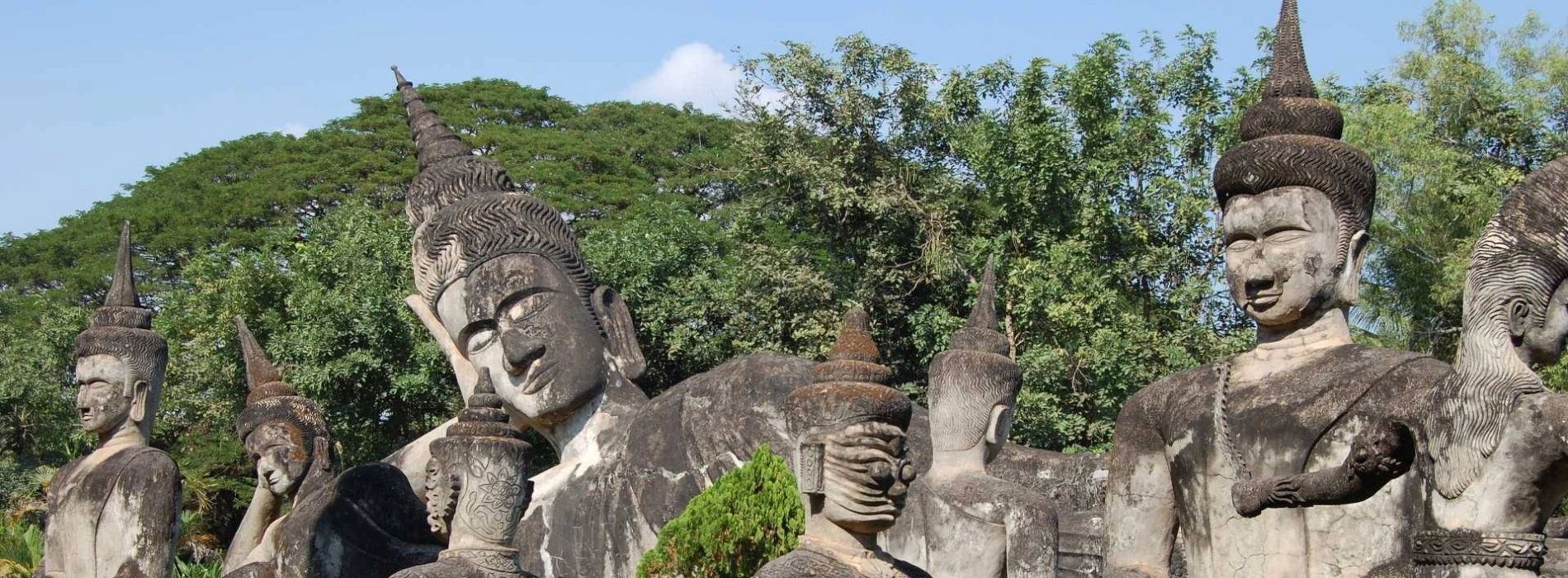
Laos, Thailand, and Cambodia are three Southeast Asian countries where Buddhism deeply influences people’s daily lives. However, unlike the other two, Laos's spiritual activities remain untouched and have not been significantly impacted by tourism. Moreover, aside from Buddhism, indigenous beliefs add unique colors to the spiritual landscape. Join Asia King Travel in exploring spiritual experiences in Laos that will help you find peace of mind.
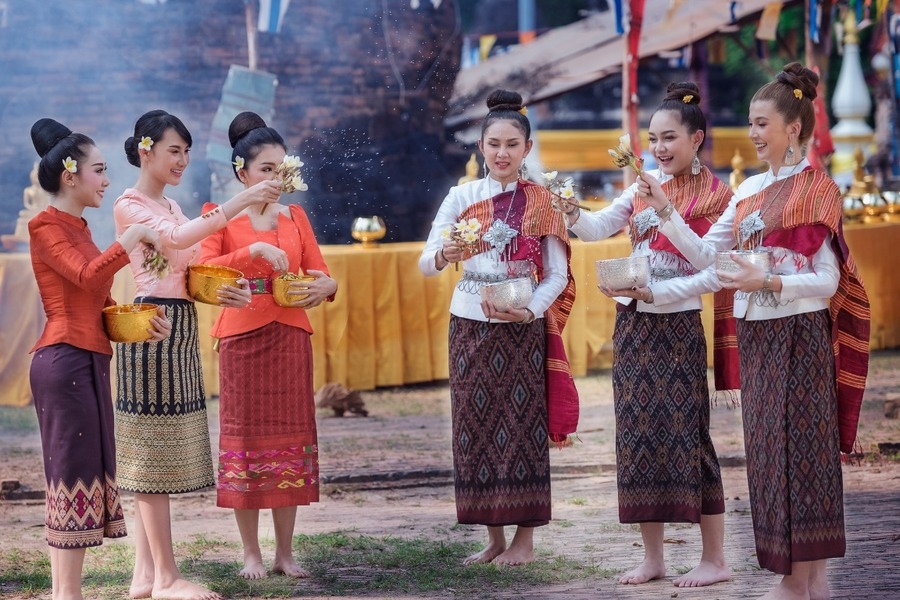
Laos has many meaningful and fascinating spiritual activities. Photo: Indochina Voyages
Some pagodas in Laos offer meditation sessions with monks. This is an opportunity for you to temporarily escape the noise of everyday life, find peace, and gain a deeper understanding of yourself. One of the popular places for meditation is Wat Sok Pa Luang in the capital city of Vientiane. The temple's serene atmosphere, surrounded by greenery, provides an ideal environment for focusing the mind.
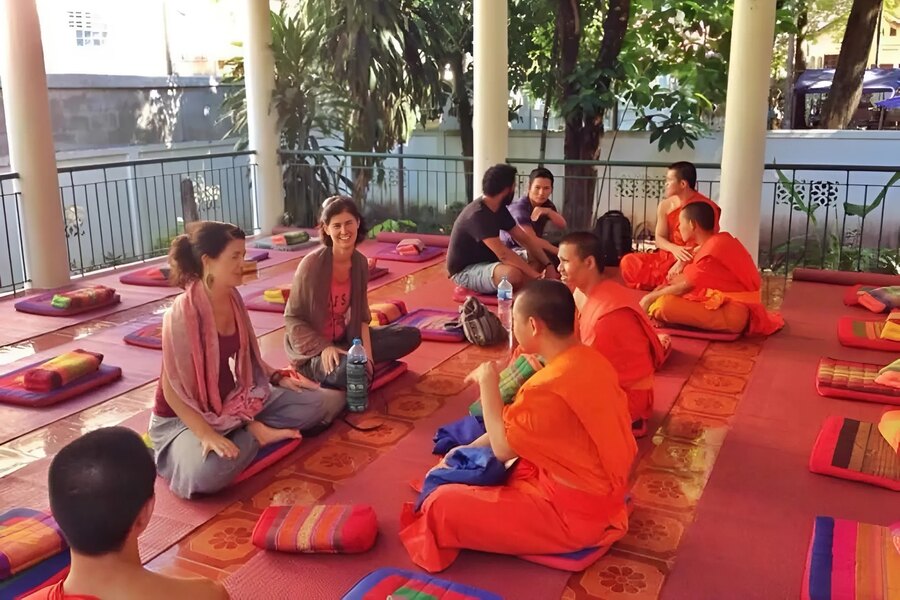
The monks are willing to teach you meditation and share Buddhist teachings. Photo: thewholeworldornothing
Every Saturday afternoon and Sunday morning, the temple allows visitors to practice Vipassana meditation and engage in conversations with the monks. By participating, you will learn how to calm your mind and gain valuable insights into Buddhist teachings about life.
Starting from the 14th century, the almsgiving ceremony originated from the monks' practice of living a life without material concerns and relying on offerings from the people for food. The morning almsgiving, or Tak Bat, is a way for the people to accumulate merit and show respect to the Buddha. For the monks, almsgiving is a part of their spiritual practice, helping them cultivate humility and let go of desires.
The almsgiving ceremony begins very early, usually around 5 AM. The monks walk from the pagodas to the main streets, bringing a large bowl. Local people and visitors prepare vegetarian meals, cakes, and fruits, then kneel or sit on the ground to offer them to the monks. The ceremony takes place in complete silence. People usually join their hands in a brief prayer before offering and in response, the monk will also pray to bless them.
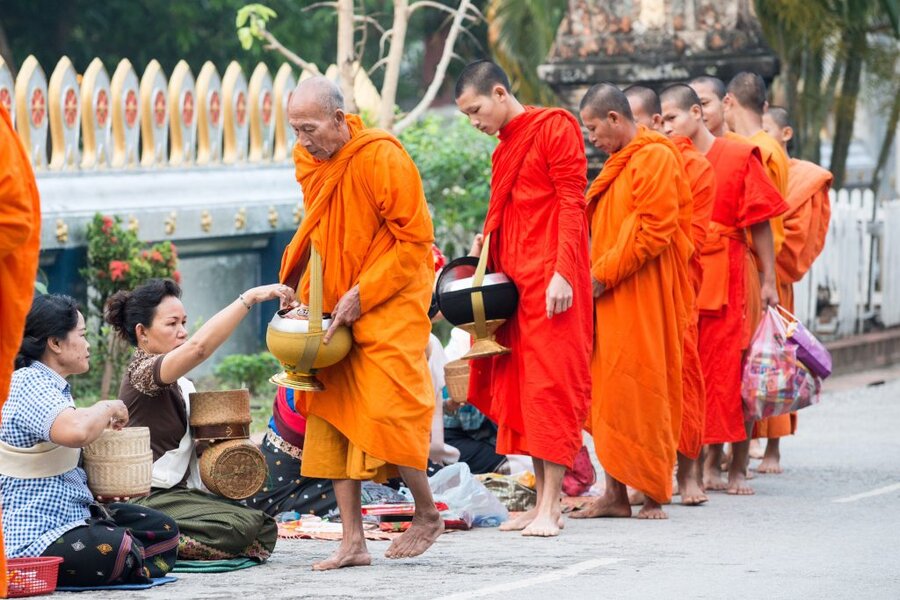
It's not just about giving food, offer it with sincerity and respect to the monks. Photo: Daniel Marchal
The monks do not distinguish between the offerings, they accept everything with gratitude and respect. Afterward, the monks will keep only enough food for the day from what they received from the people, and the rest will be given to the poor and those in need.
Around 6:30 AM, as the morning sunlight begins to shine over the distant mountain range, people gradually disperse, and the orange and yellow robes of the monks fade away from the main street, marking the end of the almsgiving ceremony. You can join this ceremony held regularly on the streets of Luang Prabang.
The Buddha statue bathing ritual symbolizes purification, cleansing both the body and mind, helping participants dispel worries, illnesses, and pray for a peaceful life. During the ceremony, the Buddha statue is washed with fragrant water infused with flowers and natural ingredients, representing purity and renewal. This ritual takes place only on Vesak Day - the most significant festival in Buddhism, which occurs on the 15th day of the fourth lunar month (around May).
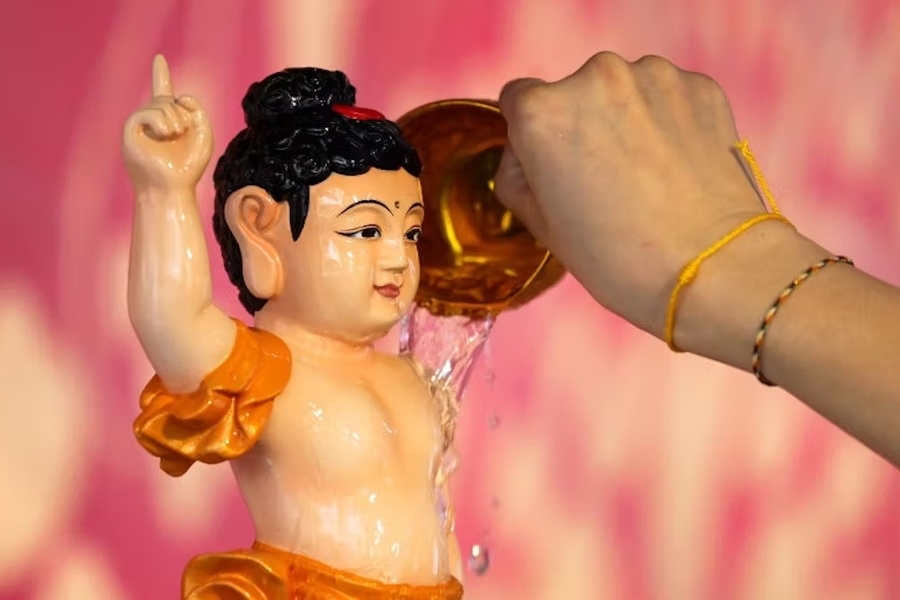
Water cleanses both the body on the outside and your soul within. Photo: The Conversation
Most major pagodas in Laos welcome visitors to participate in Vesak Day celebrations. After the abbot performs the ceremony, people line up in turn to pour water over the Buddha statue. When it’s your turn to take part in the ritual, you will be asked to wash your hands thoroughly and take a small ladle of water. When pouring, do so gently over the Buddha's shoulders, avoiding the head as a sign of respect.
Baci ceremony is a unique Lao tradition, symbolizing wishes for luck, peace, and protection from misfortune. When a red thread is tied around the wrist, it is not only a sign of good fortune but also a reminder for the wearer to do good deeds in order to receive goodness in return.
This custom is usually performed during major festivals or when someone visits a temple to seek blessings for an important event. The ceremony takes place in the peaceful atmosphere of a temple, where monks chant prayers to bless the participants before tying the thread around their wrists.
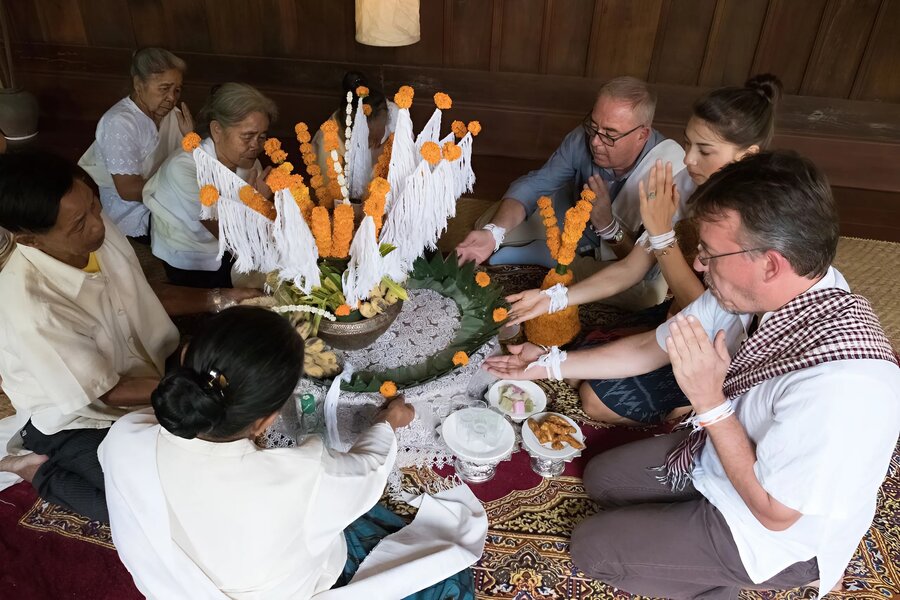
A lucky charm for you. Photo: Laos Travel
First, you will kneel before the monk and press your hands together in the "Nop" gesture, a common sign of respect in Laos. Then the monk will take a thread that has been blessed through prayers and gently wrap it around your wrist. While tying the thread, the monk will often recite a short chant to bestow blessings, wishing the recipient good health, peace, and good fortune.
According to Lao beliefs, the red thread should not be removed intentionally but left to fall off on its own, as this is seen as a sign that the blessings have been fully received. Some people even believe that the longer the thread stays on, the more good fortune it brings. Baci ceremony can be performed for a family or a group of friends, so don’t forget to invite your loved ones to receive blessings together during your trip to Laos!
Suggested for you: Vientiane's Spiritual Journey: Top Temples to Explore in 2025
Traditional festivals in Laos are spiritual events and lively celebrations filled with exciting activities. Boun Pi Mai, the biggest festival of the year, takes place around mid-April to mark the Buddhist New Year is the best example.
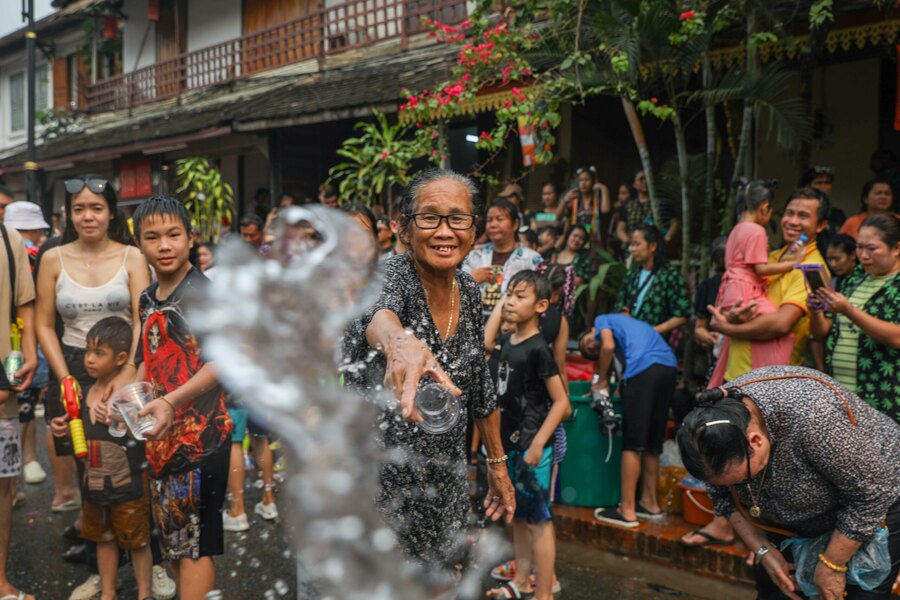
Lao people send you their best wishes through water. Photo: Southeast Asia Globe
One of the most exciting parts of the festival is the water-splashing tradition, which symbolizes washing away bad luck and bringing good fortune. If you join this festival, be ready to get soaked by the locals. It’s their fun and joyful way of blessing you!
Boun Bang Fai is a festival for those who enjoy excitement and liveliness. This festival usually takes place in May or June to pray for an upcoming rainy season favorable for the crops. The highlight is the homemade rockets in interesting shapes launched into the sky, symbolizing the plea to the gods for rain.
Head to Naxone Village in Pakngum District, about 50 kilometers from Vientiane. This is where the festival is celebrated on the largest scale compared to other places. Enjoy the vibrant performances while immersing yourself in the festival’s lively atmosphere!
At the end of the year, the Boun Awk Phansa festival takes place. On festival nights, people release beautiful floating lanterns onto the Mekong River as a sign of respect to the Buddha. To prepare for the festival, families make small boats to hold candles, flowers, incense, food, or money. Large lanterns are also paraded through the streets, creating a sacred yet dazzling spectacle.
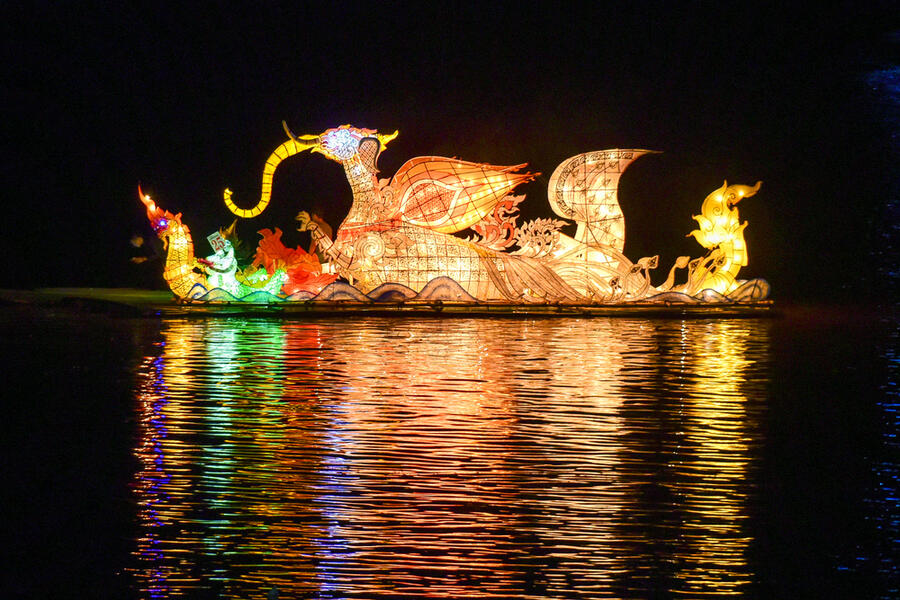
The giant lanterns are paraded through the streets and released onto the Mekong River. Photo: iVIVU
Come to Laos and immerse yourself in captivating spiritual experiences that are anything but boring. Each ritual carries a profound meaning, reminding you how wonderful life truly is. Contact Asia King Travel to discover one-of-a-kind spiritual journeys in Laos!
Suggested for you: Exploring Spiritual Marvels: 10 Temples Should Be Visited When Coming to Laos